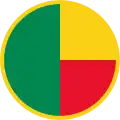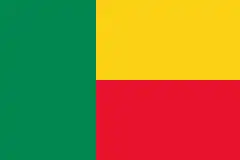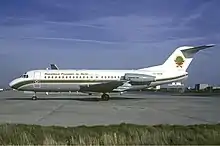| Benin Air Force | |
|---|---|
| Forces Aériennes du Benin | |
| Country | |
| Type | Air force |
| Role | Aerial warfare |
| Part of | Benin Armed Forces |
| Headquarters | Cotonou |
| Commanders | |
| Current commander | Lieutenant-colonel Hermann William Avocanh |
| Insignia | |
| Roundel |  |
| Fin flash |  |
| Aircraft flown | |
| Transport | de Havilland Canada DHC-6 Twin Otter, Hawker Siddeley HS 748 |
The Benin Air Force (French: Forces Aériennes du Benin or FAB) is the aerial service branch of the Benin Armed Forces. It was formed in 1960 when Benin gained independence from France as the Dahomey Air Force. The Air Force provides support to the army, primarily through transport and liaison, and presidential transportation. It has relied heavily on donations, initially from France and more recently from Belgium. During the short lived People's Republic of Benin, when it was known as the Benin People's Air Force, Soviet aircraft were acquired to demonstrate the change of political allegiance. The current operational fleet consists of two aircraft.
History
Beginnings
When the Republic of Dahomey became a self-governing colony in the French Community on 11 August 1958, the colonial power provided the new country with a small nascent air arm named the Dahomey Air Force (Force Aérienne de Dahomey or FAD).[1] The first aircraft arrived in 1961 after the country had gained full independence. The original donations, a Douglas C-47 transport and an Sud Aviation Alouette II helicopter along with a number of Max Holste Broussard utility aircraft, a similar package that France provided to many of its ex-colonies when they gained their freedom, were soon complemented by an Aero Commander 500B VIP transport.[2] The C-47 fleet was expanded to three aircraft and, in 1973, a French-manufactured Rheims Cessna Skymaster was added to the force.[3] To supplement the Aero Commander, an Aérospatiale Corvette was acquired, further reinforcing the tie between the country and French aircraft industry.[4]
Benin People's Air Force
.svg.png.webp)

On 30 November 1975, the nation of Dahomey was renamed the People's Republic of Benin and the air force became the Benin People's Air Force (Forces Aériennes Populaire du Benin or FAPB).[5] A new roundel was introduced that included a red star to designate the new political allegiance of the country. Internally, however, little changed. The air force initially saw no new purchases except a single Fokker F27-600 added in 1978.[4] Soon after, two Antonov An-26 transports were introduced, heralding a change in allegiance to the Eastern bloc.[5]
During the next few years, the air force continued to expand but so did costs. To curb these, and to also support economic development in the country, in 1984, the Air Force started to jointly operate its larger transport aircraft with the national airline, Transports Aeriens de Benin. At the same time, the air force returned to procuring aircraft from West Europe. By 1987, the fleet included two An-26, three C-47s and two Dornier Do 128-2 transports, an Aero Commander 500B and Fokker F28 Fellowship for VIP transport, and a single Alouette II and two Aérospatiale AS350 Écureuil helicopters.[6]
Benin Air Force
When the country's name was changed again on 1 March 1990 to the République du Bénin, the name of the air force was also renamed to the current name.[1] The original roundel was restored, although the red star was still visible on aircraft in 1994.[7] Some things stayed the same. The air force continued to operate under financial constraints, which increasingly impacted serviceability. To help solve this, the country was provided aid from Belgium.[8] The C-47 transports were retired, along with the remaining older aircraft. The Belgian Air Force provided a three-year service programme and also three Hawker Siddeley HS 748 transports. One of these was used for spare parts in an effort to provide continuity for the fleet, another recurring problem.[8] Helicopters were also later provided by the Belgian Army under the same condition.[9] A de Havilland Canada DHC-6 Twin Otter utility aircraft joined the two An-26 transports in joint operation with the national airline and collaboration with civil aircraft operations became an increasingly important part of the way that the service operated.[10]
In 2010, the air force added a pair of LH Aviation LH-10 Grand Duc light aircraft in an attempt to reduce costs as well as add capability.[11] However, despite these measures, the operational fleet continued to shrink. By 2018, the air force consisted of two active aircraft.[12]
Current Capabilities
The Air Force is tasked with a range of military tasks, including national defence, surveillance and intelligence gathering, support to the Army and VIP transportation and participation in peace keeping operations. It also undertakes a number of other roles, including search and rescue, environmental protection, anti-poaching patrols and fighting smuggling.[13] The Air Force is increasingly also involved in joint anti-terrorism exercises.[14]
Organisation
The Air Force is led by the Chief of Staff of the Air Force (Chef de d’Etat-Major des Forces Aériennes or CEMFA). On 14 November 2016, Lieutenant colonel Hermann William Avocanh was appointed to this role.[15]
Two bases are operated, Base Aériennes de Cotonou (BACO) and Base Aériennes de Cana (BACA) at Cadjehoun Airport, Cotonou, and Cana Airport respectively.[16] In 2018, the latter was commanded by Captain Luc Biobou.[17]
Aircraft
Current inventory
| Aircraft | Origin | Type | Variant | In service | Notes | |
|---|---|---|---|---|---|---|
| Transport | ||||||
| DHC-6 Twin Otter | Canada | transport | 300 | 1[18] | ||
| Helicopter | ||||||
| Eurocopter AS350 | France | utility | H125M | 2[19] | ||
| Eurocopter AS332 Super Puma | France | utility | 3[20] | |||
Retired Inventory: Dornier Do-28 Skyservant, Bell 47G, Fokker F.28, Fokker F27-600, Boeing 707, Rockwell 500 Commander, Antonov An-26, Antonov An-2, Max Holste Broussard, Douglas C-47, Cessna Skymaster, Aérospatiale Corvette, Sud Aviation Alouette II.
Golf legend
There is a story that a golfer named Mathieu Boya destroyed the entire Benin Air Force in 1987 with a golf shot that led to one of the force's Dassault Mirage fighters crashing into the remaining four.[21] Unfortunately for the story, the Benin Air Force has never operated the Mirage or any combat aircraft.[6]
References
Citations
- 1 2 Wragg 2003, p. 23.
- ↑ Rawlings 1971, p. 927.
- ↑ Wheeler 1973, p. 144.
- 1 2 Wheeler 1980, p. 1327.
- 1 2 Wheeler 1980, p. 1326.
- 1 2 Hatch 1987, p. 42.
- ↑ Moulin 1994.
- 1 2 Ripley 2004, p. 45.
- ↑ Decock 2012.
- ↑ Housnou 2018, p. 26.
- ↑ Guisnel 2010.
- ↑ Hoyle 2018, p. 12.
- ↑ Ministère de la Defense Nationale. "Forces Aériennes". defense.bj (in French). Retrieved 24 August 2019.
- ↑ Lawson 2018.
- ↑ Housnou 2018, p. 27.
- ↑ Youri 2018, p. 8.
- ↑ Youri 2018, p. 9.
- ↑ Hoyle, Craig (2022). "World Air Forces 2023". Flightglobal Insight. Retrieved 23 November 2022.
- ↑ "Benin's Air Force Boosts Counterterrorism Efforts with New H125M Helicopters". Military Africa. 2023-06-24. Retrieved 2024-01-13.
- ↑ "Benin receives Puma Helicopters from France to enhance Counter-Terrorism fight". Military Africa. 2023-07-07. Retrieved 2024-01-13.
- ↑ Connor 2001, p. 63.
Bibliography
- Connor, Floyd (2001). Golf's Most Wanted: The Top 10 Book of the Great Game's Outrageous Duffers, Deadly Divots, and Other Oddities. Washington, D.C.: Brassey's. ISBN 978-1-57488-360-2.
- Decock, Jean-Paul (13 May 2012). "L'hélico démo nouveau est arrive". Hangar Flying (in French). Retrieved 24 August 2019.
- Guisnel, Jean (21 November 2010). "Le Grand Duc, un avion pour l'Afrique". Le Point (in French). Archived from the original on 17 September 2016. Retrieved 24 August 2019.
- Hatch, Paul (28 November 1987). "World Air Forces 1987". Flight. 132 (4090): 37–106. Retrieved 24 August 2019.
- Housnou, Lucien; et al. (10 September 2018). "Entretien Avec Le Lieutenant-Colonel Hermann Avocanh, Chef D'etat-Major Des Forces Aériennes "Il faudra réorganiser les Forces Aériennes"" (PDF). Le Mirador (in French). 16: 24–27. Retrieved 24 August 2019.
- Hoyle, Chris (2018). "World Air Forces 2018". Flight Global. Emmen: RUAG.
- Lawson, Ben (23 November 2018). "Menace terroriste : le Bénin organise des manœuvres militaires". La Nouvelle Tribune (in French). Retrieved 24 August 2019.
- Moulin, Jacques (1994). "Les Forces Aérienne Béninoises". le bloc (in French). Retrieved 24 August 2019.
- Rawlings, John (24 June 1971). "World's Air Forces". Flight. 99 (3250): 922–940.
- Ripley, Tim (16–22 November 2004). "World's Air Forces 2004". Flight International. 166 (4960): 41–100. Retrieved 24 August 2019.
- Wheeler, Barry (26 July 1973). "World's Air Forces". Flight. 104 (3359): 139–162.
- Wheeler, Barry (4 October 1980). "World's Air Forces". Flight. 118 (3726): 1323–1378.
- Wragg, David (2003). Jane's Air Forces of the World: The History and Composition of the World's Air Forces. London: Collins. ISBN 978-0-00711-567-9.
- Youri, Alladaye (29 May 2018). "Echanges de Vœux de Nouvel an Chez les Aviateurs: Le CEMFA Prend un Nouveau Départ avec la Troupe" (PDF). Le Mirador (in French). 14: 8–9. Retrieved 24 August 2019.